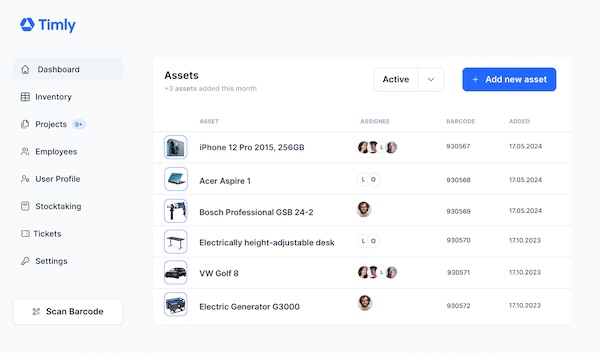Active vs Passive GPS Tracking in Asset Management: Pros and Cons
In this article:
- What is GPS tracking in asset management?
- What’s the difference between active vs. passive GPS tracking?
- Why is location monitoring important in inventory management?
- Benefits of passive GPS tracking
- Benefits of active GPS tracking
- Which is better for your company – real-time GPS or QR codes?
- Timly Asset Management Tool – From Barcodes to IoT
Optimise asset tracking with barcode and IoT technology from Timly.
What is GPS tracking in asset management?
Active vs. passive GPS tracking – which is the better option for managing your business assets? Before we get into this, let’s look what GPS is.
GPS stands for global positioning system, an interconnected network of satellites and ground stations which pinpoint the specific physical location of any device with a GPS receiver – including phones and tablets – and make this data available to applications or other processes.
GPS tracking in asset management utilises this advanced and highly accurate positioning system to track and account for the specific location and movement of any physical asset in your company, including fleets and vehicles, tools and maintenance equipment, computers and other IT hardware, or any other moveable or stationary item, allowing the asset management software to use this data in many relevant and beneficial ways.
What’s the difference between active tracking vs. passive tracking?
There are two basic approaches to GPS tracking of assets – active, or real-time, and passive. Passive tracking may only check and record an asset’s location once, or a few times, while active tracking continuously checks an item’s location and updates the information.
Passive tracking pinpoints an asset’s location when it is initially entered into the asset management software, and updates the location every time that physical asset is checked out for use, moved, changed in status, or otherwise rescanned. Often this is accomplished using QR codes, which are attached to the physical asset and are scanned by an employee’s smartphone or tablet, using that device’s GPS receiver for precise location.
Active tracking, on the other hand, assigns a separate GPS receiver to a physical asset, rather than relying on an employee’s device for location. The GPS sensor is physically attached to the asset, and sends regular location information to the company’s inventory tracking software, allowing for not just the most precise, but also the most up to date and trackable, accounting of asset location.
Over 600 Companies, Schools and Cities Rely on Timly
Why is location monitoring important in inventory management?
We have published other articles on the many advantages of GPS tracking in general, and how important it is to asset management, digital transformation and a company’s operations – you can find much more in our recent piece GPS Software and Its Use in Asset Tracking.
Suffice it to say that any form of precise location tracking, in concert with comprehensive asset management software, can make your workflows more efficient and productive, extend asset life and reduce maintenance costs, improve security and prevent shrinkage, ensure regulatory compliance, and in so many ways improve operations, increase revenue and save money.
But here let’s instead focus specifically on the pros and cons of active GPS tracking versus passive location tracking.
Benefits of passive GPS tracking
Compared to active tracking via dedicated GPS transceivers, passive GPS solutions offer some real advantages:
∗ They are significantly less expensive.
∗ They are already integrated into the best asset management platforms, so no additional setup or configuration is required.
∗ They are more easily adaptable / scalable, since new or changing assets can be accommodated simply by adding QR codes.
∗ They increase employee awareness and accountability, by requiring manual scanning for all usage, scheduling, movement and maintenance.

Timly’s software explained in under 2 minutes
Keep an Eye on Everything via Timly’s Smart Asset Tracking Software
(No credit card required)
Benefits of active GPS tracking
∗ Real-time data provides the most up to date information about location and usage.
∗ Adherence to policies around asset usage, borrowing, movement and maintenance is ensured, and discrepancies automatically flagged.
∗ Fleet and vehicle management is greatly enhanced, as GPS trackers can provide optimal routes, better coordinate usage, decrease wear and tear, maintenance and fuel costs, and increase vehicle life.
∗ Active sensors may work better in remote locations without cellular coverage.
∗ Security, loss prevention and recovery are improved, and related costs – ie, security staffing and insurance premiums – are reduced.
∗ Compliance with certain insurance, legal, statutory and other external regulations is improved and verifiable.
Which is better for your company – Real-time GPS or QR codes?
Both active and passive GPS tracking are enormously beneficial services, but while we can categorically say that any and every business can greatly benefit from passive location monitoring, which should be a basic element in any asset management solution, how can you decide whether the more expensive option of active location tracking with GPS sensors is also good, or even necessary, for your business?
Let’s look at some different scenarios where this option may make sense:
∗ Fleet management – If you have a medium to large fleet of vehicles, or a smaller fleet with high usage and high fuel and maintenance costs, adding GPS tracking sensors to those vehicles may be a very smart decision.
∗ High Value Items – For assets which are very costly or valuable, critical to operations and/or difficult to replace, GPS monitoring with real-time data may in fact be mandatory.
∗ Security – For remote operations, areas with higher security risks, contractors or non-vetted workers, or expensive items that are regularly checked out and moved around, dedicated GPS sensors can greatly increase security and reduce related costs.
∗ Critical workflows – Machinery, equipment, vehicles, tools or supplies that are absolutely necessary to critical processes or workflows may need to be tracked in real time, especially when potential disruptions can be costly or damaging to the company.
∗ Compliance – Real-time tracking of position and movement of certain assets can help comply with internal and external (insurance, financial, governmental, statutory) regulations around location, use and maintenance, and may in fact be required.
Timly Asset Management Tool – From Barcodes to IoT
An affordable approach, like Timly’s organically integrated QR scanning and passive GPS tracking, can markedly improve your company’s productivity, reduce employee stress and wasted effort, increase the utility and life of assets, improve security and so much more. In fact, we see passive location tracking as an absolutely mandatory and central part of inventory management and digital transformation.
At the same time, we want to ensure that the more advanced features and functionality of active GPS tracking are available to our customers, now and in the future. To this end, we have partnered with adnexo, a leader in data sensors and the IoT (internet of things). By seamlessly integrating adnexo sensors into our platform and solutions, Timly is in the perfect position to offer passive GPS location tracking by default and active tracking as an easily realised and relatively affordable option.
Timly’s software makes it possible to manage your business assets at any time and from anywhere.
Our sales and support team is available to answer any additional questions you might have about GPS, its importance in asset management, and its specific applicability to your company, and you can also review many specific customer use cases at our site.
Recommended for you:
Book an online demo - free and without obligation - or create your free trial account directly.


